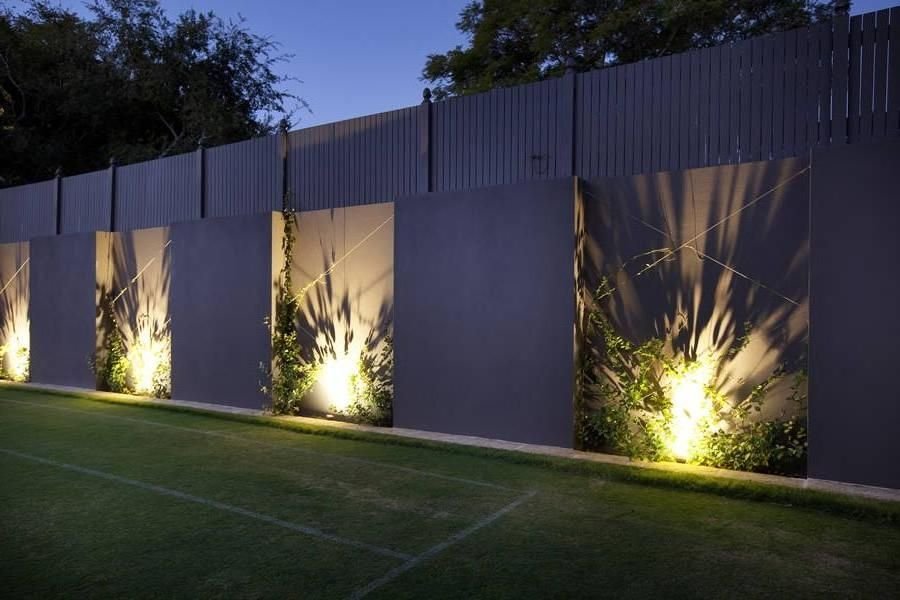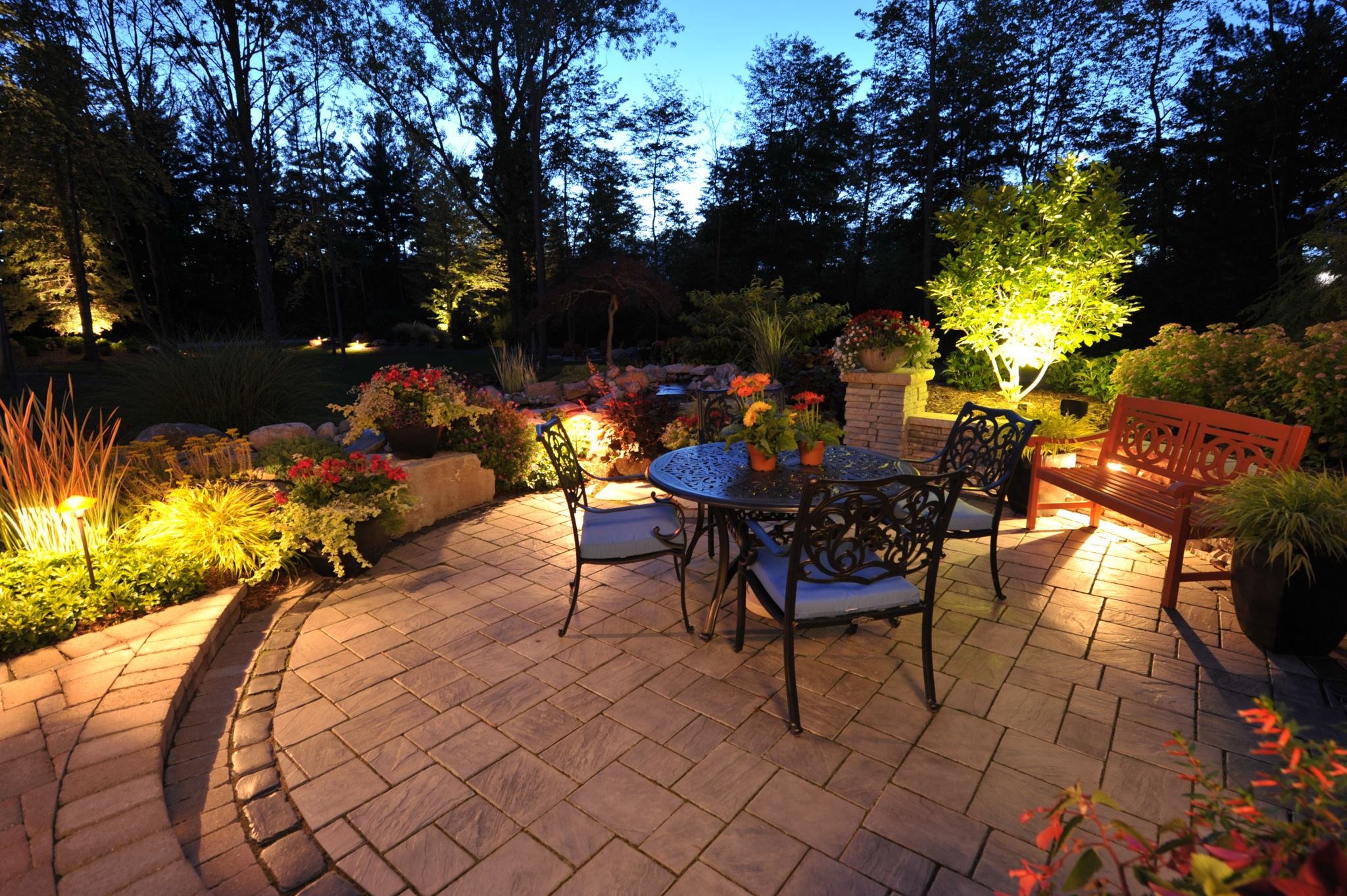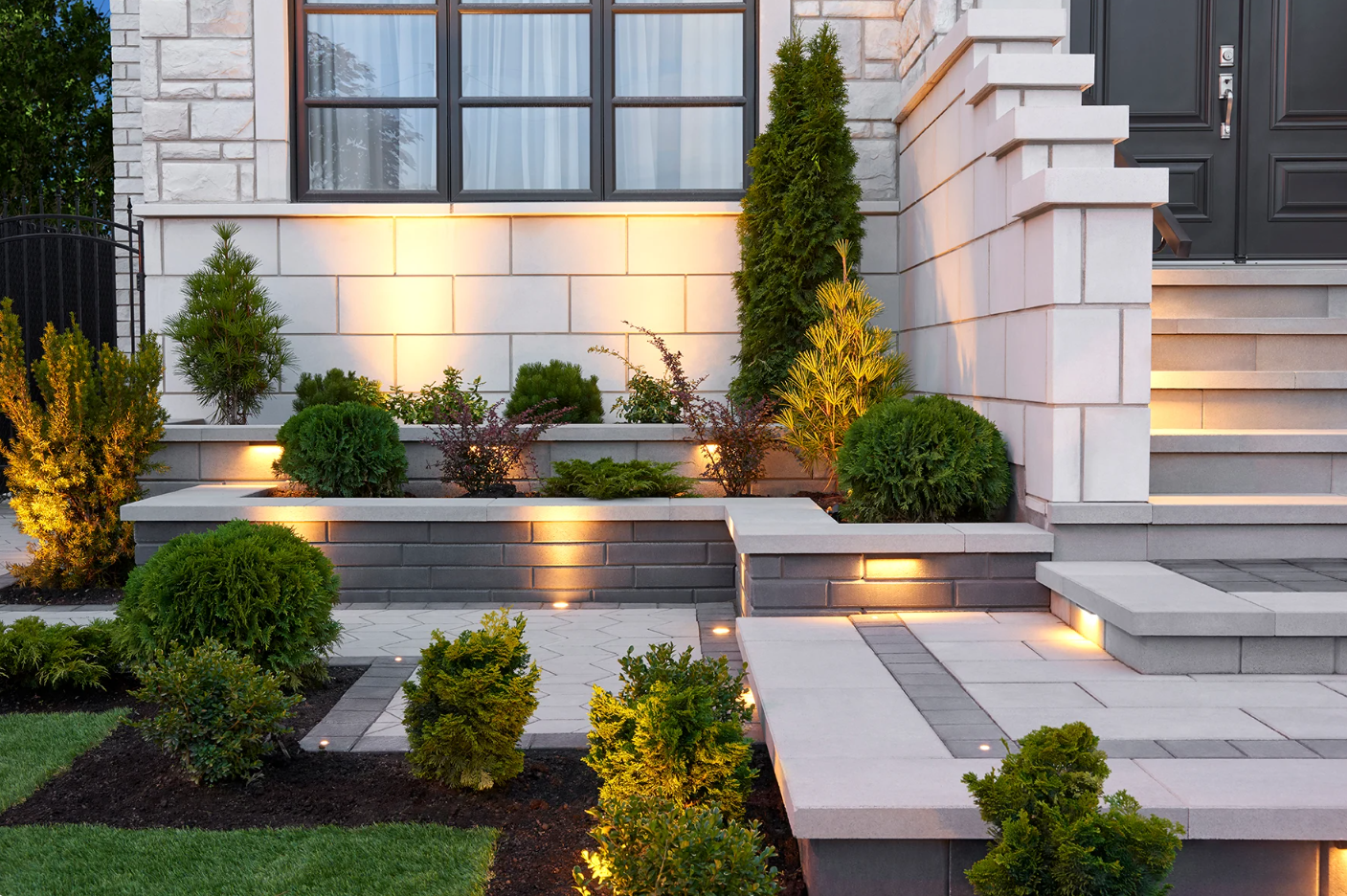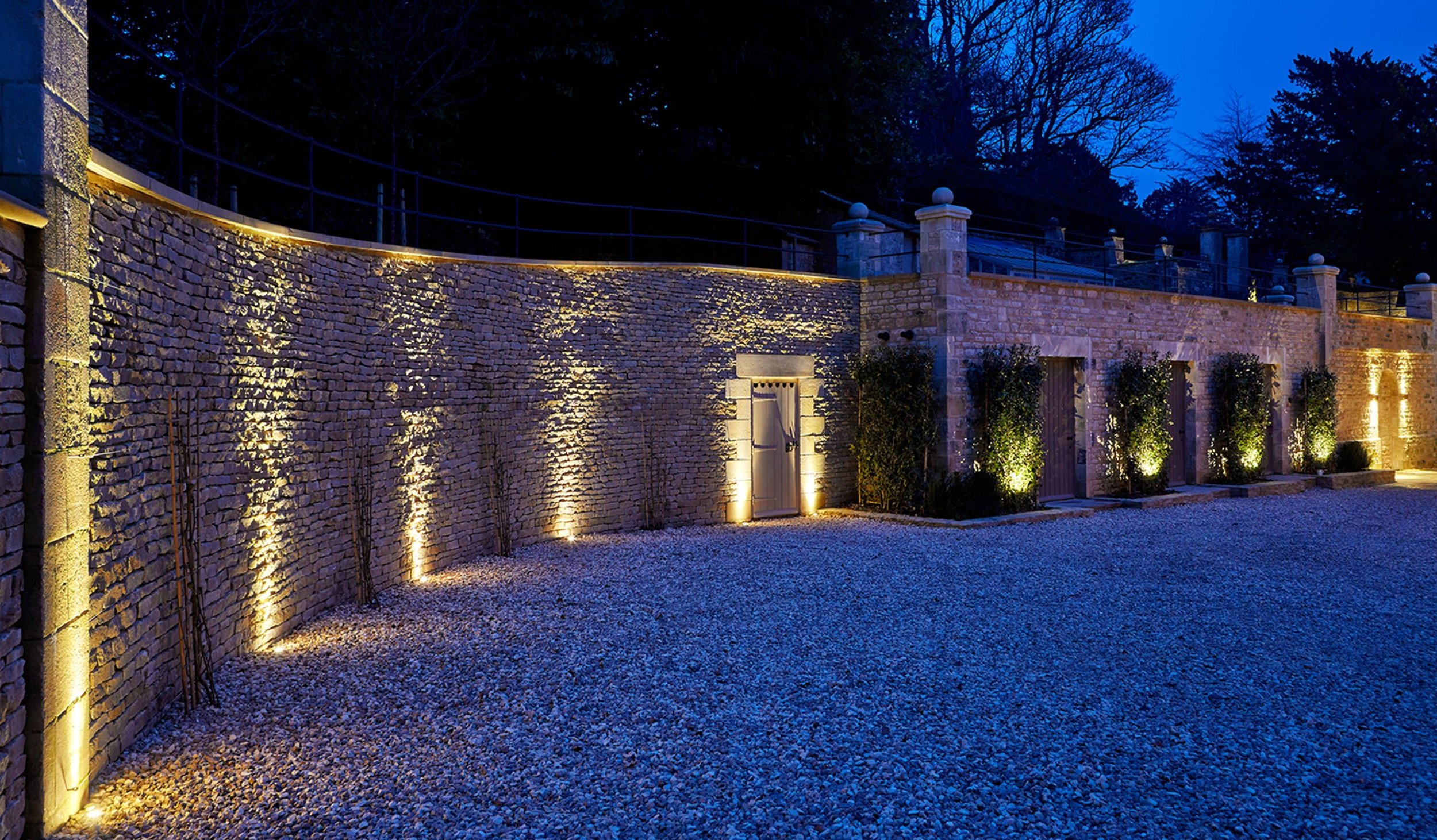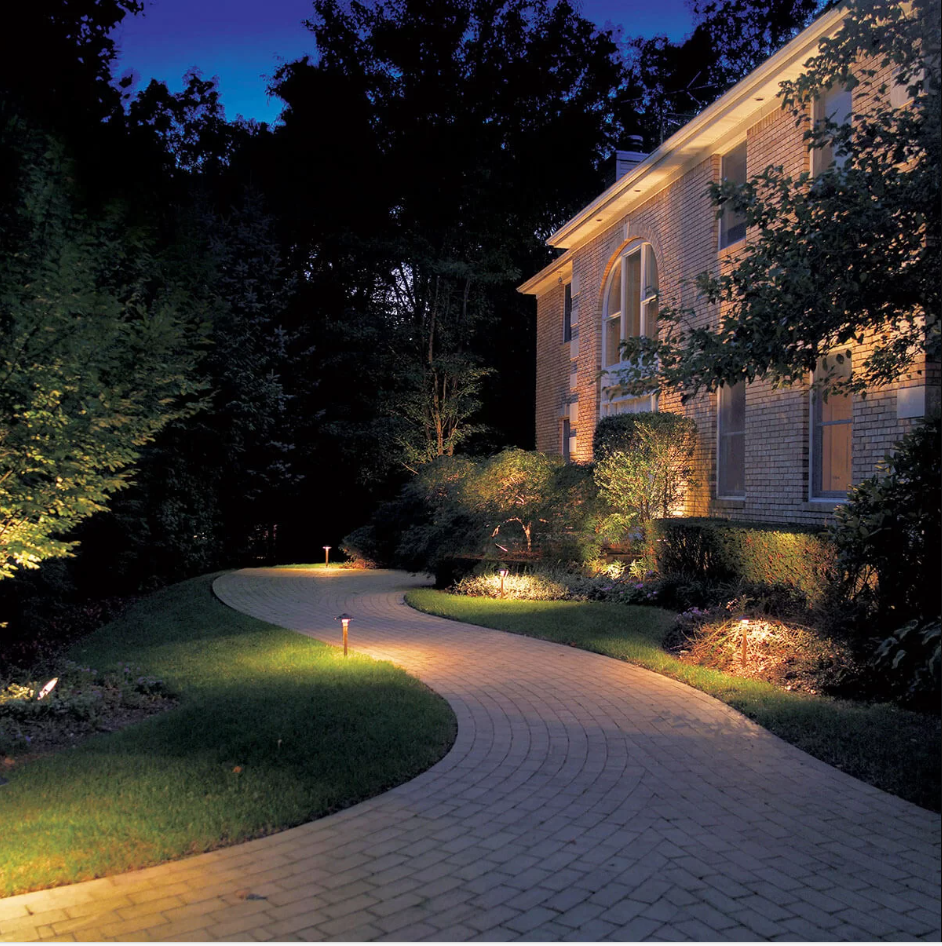8 Spots to Maximize Landscape Light Coverage
Want to add landscape lights to your outdoor spaces? We've gathered a list of the best fixtures and placements for your property. Whether you're looking for increased home security, increased visibility from the road, or simply wanting to light up your outdoor living spaces, we've got ideas for you!
Exterior Walls
Take the first photo as an example of how not to place your exterior uplights. Notice the huge shadows cast by the bushes? Fixtures should be placed away or angled away from bushes to prevent these shadows. If this can’t be done, your landscaper can easily trim back the hedges to allow full lighting coverage. Despite problems from hedge overgrowth, well-placed wall uplighting is a great way to light up large portions of your home and highlight it’s exterior texture, whether brick, stone, stucco, or siding. To adequately cover the front walls of your home, you will need 3-4 fixtures for a smaller home and up to 10-12 for a large house with many ins and outs.
2. Gables
Notice how the two top photos feature lights mounted in the top peak of the gable, shining down. This opposed to the last photo in which the gables are lit from one or both bottom corners. We don’t recommend lights in both top and bottom as that provides too much light to a small area. The third photo features a led strip light mounted along the inner sides of the gable bargeboard for a cool, modern aesthetic that looks great on the stone but doesn’t quite match this home in my opinion. Use gable lights for aesthetic purposes to emphasize height and add visibility to your home’s features.
3. Trees
Great landscaping highlights the natural beauty of your property and integrates your home with the environment surrounding it. But don’t think you can only enjoy that beauty during the day. Uplighting for trees can be a great way to showcase your slice of nature at night. Whether making a grand entrance to your driveway or lighting up your favorite backyard tree, every home can benefit from well-placed tree lights.
4. Stairs
Check out the different placement of lights on these stairs. Installed correctly, no stair fixtures should shine directly outwards into your face as in the second photo. Thus, lights mounted on the steps rather than beside, typically provide the best functionality and least interference. For maximum coverage, the third photo features a warm white led strip light mounted on the bottom lip of the step extending almost the full length. This allows the fixture to be completely invisible and prevents lights shining directly in your eyes but also lights a much wider area of the step, creating a welcoming, yet modern style.
5. Fence
Although not as common as lighting the front of the house, fence and perimeter wall lighting works wonders at creating a functional, inviting nighttime space. They’re a great alternative to overhead string lights that undoubtedly look amazing at most patios or pool decks, but which, in particular situations, can seem to close off and crowd an open overhead space. Perimeter lighting, therefore, allows you to light up the edges of your space with less of a closed-off feeling.
Depending on your desired function for fence lights, you may want to consider different placement options. If lighting a narrow pathway where staking a light into the ground would intrude upon already limited ground space, consider mounting small, inconspicuous downlights at the top of the fence. Two-way sconces along a fence or wall work great for lighting up both a walkway/ground cover and overhead features. If your focus is more on outlining and highlighting features of your yard, think about accent lights at the base of your fence or perimeter wall shining upwards. You can place these so as to highlights plants or ivy growing along the fence, or simply to create evenly spaced lighting across the full length of your perimeter.
6. Garden
Using only your home’s outdoor sconces and/or spotlights at night draws attention to the man-made structures of your property, often ignoring the beautiful greenery. Well-placed and widespread garden lighting not only balances the sconces and spotlights by highlighting the plants, flowers, and other greenery in your landscaping, but also beautifully compliments the ambient lighting by getting light to the outer edges of your space, something sconces and spotlights often fail to do.
Note the variety of fixtures used in these examples. For small shrubs and flowers, bright path lights can be a great way to keep light focused on the ground. On the other hand, square or round accent lights with the right beam angle and placement perfectly showcase the height of taller shrubs, trees, or ivy. For raised beds, particularly those integrated into your hardscaping, warm white strip lights are a great option for evenly maximizing light coverage where other stake-mounted accent fixtures may fail to do so. In conclusion, if you’re looking to boost ambient lighting and balance out structure-mounted lighting in any area of your property, garden lights may be the answer.
7. Retaining Wall
Another awesome way to provide a soft light to your front or backyard space is with landscape lights on your retaining wall. Up or downward shining lights can bring out the beautiful texture of your brick or stone wall. If mounting lights on the ground to shine upwards, make sure landscaping is neatly trimmed so as not to block light from reaching the wall. Symmetrically spaced lights can really emphasize the length of your wall and add a nice, ordered balance to the diverse mixture of your plants and landscaping. As you can see in the first, third, and fourth photos, retaining wall lights can greatly enhance nighttime visibility of the entire area. However, even if you don’t need functional lighting, retaining wall lights also bring out the diversity of your hardscaping and landscaping as shown in the second photo.
8. Path Lights
And finally we have the last great spot to place landscape fixtures: pathways. Undoubtedly, you have some sort of pathway on your property and if it doesn’t have the necessary lighting, you’ve probably tripped once or twice or wished you had lights that one time you dropped your keys. Before you get path lights installed, here are several things to consider.
1. If you have a concrete or other solid material pathway, is one side completely cut off from the house? In other words, how will you run low voltage cable to the new lights on the side away from the house? If you have a concrete pathway, wires may have to be detoured around the beginning or end of the pathway, as digging directly under can be a costly operation that may not justify a few path lights and cutting a groove straight across simply would destroy the look of a non-patterned stone walkway. Keep this in mind for any other types of lights you plan to install as well. On the other hand, if your pathway only has separated stones without grout or a very symmetrical pattern of stones or brick with grout, wires can often be safely and inconspicuously wedged or buried between the stones or bricks after cutting a groove into a straight line of grout if necessary.
2. Keep in mind your landscapers and where they will be edging or trimming. This also applies to all types of fixtures in all different areas. Make sure lights are placed in a visible location where landscapers can easily identify them and that wires buried along a pathway are deep enough or far enough away from the edge of the path that an edger will not cut the wire.
Once you’ve figured that out, decide what type of path light you prefer. The classic style (first, second, and fourth photos) stand about 18” tall and casts light downward in a circle. Pay close attention to the lumens of the bulb used as many such path light bulbs can be very dim, too dim to provide functional lighting. If you have taller plants along your path and want to maximize functional lighting coverage, a larger path light (third photo) that casts light more outward may be a better option and could blend with the taller shrubs so as not to stand out too much.
That concludes this post, if you have any more questions or would like to discuss outdoor lighting for your home, feel free to contact us! Thanks!




















